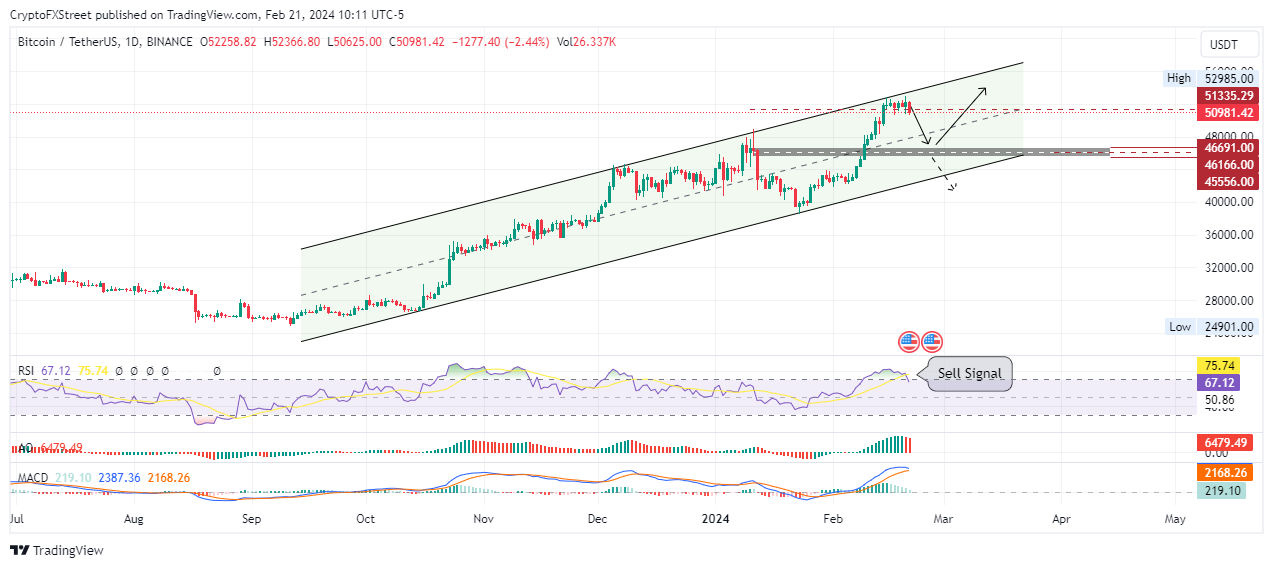Bitcoin price likely to fall but MicroStrategy’s $12 billion market cap makes it a possible S&P 500 candidate
- Bitcoin price’s immediate support at $51,335 is under threat as the king of cryptocurrency leans south.
- BTC could slide 7% to test the $48,000 psychological level before the next leg up.
- A decisive close above the $52,985 range high would invalidate the bearish thesis.
Bitcoin (BTC) price consolidation continues to stretch but steadily leans in favor of the downside. This is expected as markets tend to not wait that long. Meanwhile, Michael Saylor’s firm MicroStrategy (MSTR) is making headlines with a possible listing in the S&P 500.
Also Read: Bitcoin Price Prediction: $160 million long positions liquidated as BTC slips 2%
Bitcoin mogul Michael Saylor’s Microstrategy almost merits S&P 500 inclusion
Boasting around 190,000 BTC tokens worth almost $10 billion, business intelligence firm MicroStrategy now records a market capitalization of $12 billion. It comes after the firm made a big bet on the giant crypto, BTC, with the boldness almost earning the company a place on the American stock market’s most important index, the S&P 500.
The threshold for listing on the S&P 500, the list of America’s largest 500 publicly-traded firms, is possession of a market capitalization no lower than $15.8 billion. With such a high bar, it is not easy for a company to make it to this selection criterion. Nevertheless, MicroStrategy is progressively recording steady growth with its Bitcoin investments, catapulting itself toward the threshold with every purchase.
Besides another voluminous purchase, another factor that could propel MicroStrategy closer to the S&P 500 threshold is a show of strength by Bitcoin price. Specifically, if BTC extends north, clearing the $52,985 range high and ultimately retaking its all-time high of $69,000.
As it stands, BTC is only 23% away from its peak price, with a listing on the S&P 500 likely to inspire confidence in Bitcoin, so much so that BTC could easily start making its way into nearly every portfolio.
Other selection criteria for the S&P 500 include meeting liquidity thresholds and a consistent track record of profit-making for a minimum period of four successive quarters right before making the application.
Meanwhile, in an interview with Bloomberg, MicroStrategy CEO Michael Saylor said, “I’m gonna be buying the top forever,” adding, “Bitcoin is the exit strategy. It is the strongest asset.”
Bitcoin price outlook as MicroStrategy commits to endless BTC purchases
Bitcoin price is leaning to the south, after slipping below the immediate support at $51,335. It comes after the Relative Strength Index (RSI) executed a sell signal, crossing below its signal line (yellow band).
The histogram bars of the Awesome Oscillator (AO) are also flashing red. Those of the Moving Average Convergence Divergence (MACD) fade while edging toward negative territory. The MACD is also almost crossing below its signal line (orange band), a crossover that has historically instigated a bearish cycle.
With these features, Bitcoin price could produce a 7% fall to the $48,000 psychological level. If this level fails to hold, sidelined investors could have a chance to enter right above the supply zone turned bullish breaker between $45,556 and $46,691. However, a break and close below its midline at $46,166 would confirm an extended fall.

BTC/USDT 1-day chart
Conversely, if the bulls find strength, Bitcoin price could push north to escape the confines of the ascending channel. Such a move could see BTC clear the $52,985 range high, with a decisive move above this blockade invalidating the bullish thesis.
The next logical target for Bitcoin would be the $55,000 milestone, or in a highly bullish case, the $60,000 psychological level.
Bitcoin, altcoins, stablecoins FAQs
What is Bitcoin?
Bitcoin is the largest cryptocurrency by market capitalization, a virtual currency designed to serve as money. This form of payment cannot be controlled by any one person, group, or entity, which eliminates the need for third-party participation during financial transactions.
What are altcoins?
Altcoins are any cryptocurrency apart from Bitcoin, but some also regard Ethereum as a non-altcoin because it is from these two cryptocurrencies that forking happens. If this is true, then Litecoin is the first altcoin, forked from the Bitcoin protocol and, therefore, an “improved” version of it.
What are stablecoins?
Stablecoins are cryptocurrencies designed to have a stable price, with their value backed by a reserve of the asset it represents. To achieve this, the value of any one stablecoin is pegged to a commodity or financial instrument, such as the US Dollar (USD), with its supply regulated by an algorithm or demand. The main goal of stablecoins is to provide an on/off-ramp for investors willing to trade and invest in cryptocurrencies. Stablecoins also allow investors to store value since cryptocurrencies, in general, are subject to volatility.
What is Bitcoin Dominance?
Bitcoin dominance is the ratio of Bitcoin's market capitalization to the total market capitalization of all cryptocurrencies combined. It provides a clear picture of Bitcoin’s interest among investors. A high BTC dominance typically happens before and during a bull run, in which investors resort to investing in relatively stable and high market capitalization cryptocurrency like Bitcoin. A drop in BTC dominance usually means that investors are moving their capital and/or profits to altcoins in a quest for higher returns, which usually triggers an explosion of altcoin rallies.

